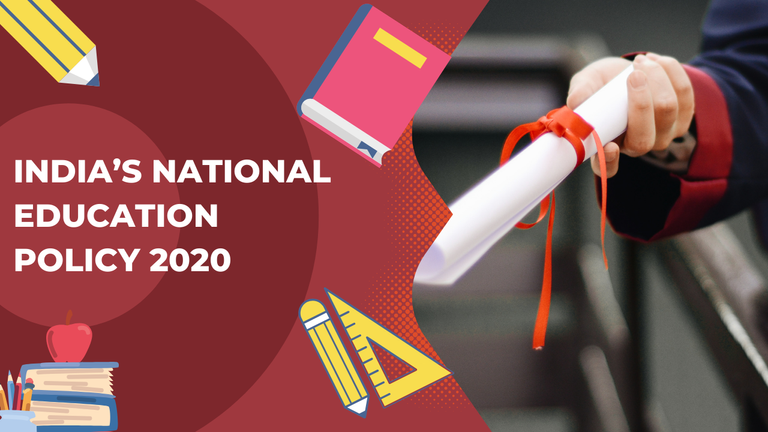An Overview of India's National Educational Policy 2020
Greetings to everyone! Every nation has structured their education policy best suited for their students. Yes, a policy can be at it’s best is somewhat arguable, cause no matter how many nook and corner you try to cover, there’s few points may left out or in future those points will arise. Like every other nation, here in India also; we have education policy which needs to be followed by government or non government schools, institutions and universities. I have to tell you guys that I have completed from my elementary school education to my masters, sticking to a policy that was prepared in 1986! Yes, 1986! You heard it right. We were following a policy that was 34 years old (till 2020) although it was revised in 1992, but that was too like 28 years back (till 2020), feeling old huh? So indeed we needed a new policy for the education sector and to nurture our future talents in the best possible way. So, here it comes the most awaited and most anticipated National Education Policy 2020. Today, I shall talk about the NEP 2020 and a overview of it in the school education.

An Overview
The NEP 2020 was the first education policy of the 21st century and as I said it replaces the 34 year old National Policy on Education (NPE), 1986. Built on the 5 foundation pillars of Access, Equity, Quality, Affordability and Accountability, this policy is aligned to the 2030 agenda for Sustainable Development and aims to transform India into a vibrant knowledge society and global knowledge superpower by making school and college education more holistic, flexible, multidisciplinary and suited to 21st century needs and aimed at bringing out the unique capabilities of each student.
The policy has been formulated after a very detailed consultative process, unprecedented in depth and scale. Consultation involved over 200,000 suggestions from 250,000 Gram Panchayats, 6600 blocks, 6000 ULBs (Urban Local Bodies), 676 districts. In June, 2017, a ‘Committee for the Draft National Education Policy’ was constituted under the Chairmanship of eminent scientist Padma Vibhushan, Dr. K. Kasturirangan, which submitted the Draft National Education Policy, 2019 to the Hon’ble Human Resource Development Minister on 31st May, 2019.
School Education
NEP 2020 aims to achieve 100% gross enrolment ratio in school education by 2030. The initiatives that will be undertaken for this include provision of effective and sufficient infrastructure, alternative and innovative education centres to ensure that children who are dropping out of school are brought back into mainstream education.
NEP 2020, emphasises on the criticality of the early years to ensure quality early childhood care and education for all children between age 3-6 years by 2025. The children in the age 3-5 will be catered to by the current system of anganwadis (kindergarten) and pre-school and age 5-6 will be included with the schooling system in a seamless integrated manner with a play-way based curriculum to be prepared by the NCERT.
New Curricular and Pedagogical Structure
With emphasis on early childhood care and education, the 10+2 structure of school curricula is to be replaced by a 5+3+3+4 curricular structure corresponding to ages 3-8, 8-11, 11-14 and 14-18 years respectively. The new system will have 12 years of schooling with three years of anganwadis/ pre schooling. The new system will cover 4 stages:
Foundational Stage : Consisting of two parts, i.e., 3 years of anganwadis and 2 years in primary school in grades 1-2 , both together covering ages 3-8.
Preparatory Stage : Consisting of Grades 3-5 covering ages 8-11.
Middle Stage : Consisting of Grades 6-8, covering ages 11-14.
Secondary Stage : Consisting of grades 9-12, covering in two phases i.e., 9 and 10 in the first and 11 and 12 in the second, covering ages 14-18.

Drawn by me using Draw.io
Holistic Education Approach:
NEP 2020 emphasizes a holistic approach to education, aiming to foster critical thinking, creativity, and greater focus on experiential learning. Students will have increased flexibility and choice of subjects so that they chose their own paths according to their talents and interests. There will be no rigid separation between arts and science, between curricular and extra-curricular activities, between vocational and academic streams. The objective is to give equal emphasis on all subjects-science, social sciences, arts, languages sports, mathematics with integration of vocational and academic streams in school.
Multilingualism and the power of language
NEP 202, emphasis on promoting multilingualism so that children know and learn about the rich and vast array of languages of their country. The medium of instruction until at least Grade 5, but preferably till Grade 8 and beyond, will be the mother tongue. Every student in the country will participate in a fun project/ activity on The languages of India, under the Ek Bharat Shrestha Bharat initiative.
Equity and Inclusion:
A key focus of NEP 2020 is to promote equity and inclusion in education, ensuring equal opportunities for all learners irrespective of their socio-economic background, gender, or disabilities. The policy proposes measures to address disparities in access to education, including the provision of scholarships, stipends, and support services for marginalized communities.
A separate gender inclusion fund will be created as a Special Education Zones for disadvantages regions and groups. Every state/district will be encouraged to establish "Bal Bhavans" as a special daytime boarding school, to participate in art related, career related and play related activities.
Technology Integration and Digital Education:
Recognizing the transformative potential of technology in education, NEP 2020 emphasizes the integration of digital tools and resources to enhance teaching and learning outcomes. It proposes the development of a robust digital infrastructure, including the provision of internet connectivity and digital devices to all schools and educational institutions. By leveraging online platforms, interactive learning resources, and educational apps, the policy aims to democratize access to quality education and facilitate personalized learning experiences.
Teacher Recruitment and Career Path
Teachers will be recruited through robust, transparent processes. Promotions will be merit-based and a mechanism for multi source periodic performance appraisals will be put in place. A common National Professional Standards for Teachers (NPST) will be developed by 2022 (completed).
India's National Education Policy 2020 represents a bold and ambitious vision for the future of education in the country. By embracing a holistic approach, promoting flexibility and innovation, and prioritizing the well-being of learners, the policy seeks to transform the education system to meet the demands of the 21st century. As stakeholders work towards its implementation, NEP 2020 has the potential to catalyze positive change and propel India towards becoming a knowledge-driven society.

If you like my work and would like to support me, you can do so by joining my fanbase by clicking this link
Ministry of Education Press Release | PIB
NEP 2020 | The New Indian Express
Quantum Confinement : Particle in a 2D box and 3D box | ChemFam #83 |
Molecular Chirality: A Mirror Image Perspective | ChemFam #82|
Exploring Time-Independent Schrödinger's Wave Equation and Particle in a 1D Box | ChemFam #80 |
The Role of Gamma Function in Quantum Mechanics | ChemFam #79 |
Postulates of Quantum Mechanics and Normalization of Wavefunction |ChemFam #78|
Understanding Commutator Relations and Exploring Eigenfunctions in Quantum Mechanics |ChemFam #77|
How to find Expression of an Operator and Commutation Relations |ChemFam #76|
Basics to Quantum Chemistry: Operators, Functions and Properties of Operators |ChemFam #75|
A Comprehensive Study of Euler's Reciprocal Rule in Thermodynamics |ChemFam #73|
A Deep Dive into Nutrition Essentials: Your Path to a Healthier, Happier You |ChemFam #72|
Decoding Liver Function Tests through Chemistry |ChemFam #71|
Understanding the Dynamic Roles of Metalloenzymes and Metal-Activated Enzymes |ChemFam #70|
Cracking the Thermal Code: Differential Thermal Analysis in Modern Research |ChemFam #69|
Applications and Importance of IR Spectroscopy: Shedding Light on Molecular Structures |ChemFam #68|
PS The thumbnail image is being created by me using canva.com
Games I play on Hive
| Games I play on Hive | Game description |
|---|---|
| Terracore | Terracore is an Idle mining game based on Hive blockchain |
| Rise of the Pixels | ROTP is a Web3 browser game about game development on Hive |


!hiqvote
@splash-of-angs63, the HiQ Smart Bot has recognized your request (1/3) and will start the voting trail.
In addition, @splash-of-angs63 gets !PIZZA from @hiq.redaktion.
For further questions, check out https://hiq-hive.com or join our Discord. And don't forget to vote HiQs fucking Witness! 😻
This post has been manually curated by @bhattg from Indiaunited community. Join us on our Discord Server.
Do you know that you can earn a passive income by delegating to @indiaunited. We share more than 100 % of the curation rewards with the delegators in the form of IUC tokens. HP delegators and IUC token holders also get upto 20% additional vote weight.
Here are some handy links for delegations: 100HP, 250HP, 500HP, 1000HP.
100% of the rewards from this comment goes to the curator for their manual curation efforts. Please encourage the curator @bhattg by upvoting this comment and support the community by voting the posts made by @indiaunited..
This post received an extra 1.06% vote for delegating HP / holding IUC tokens.